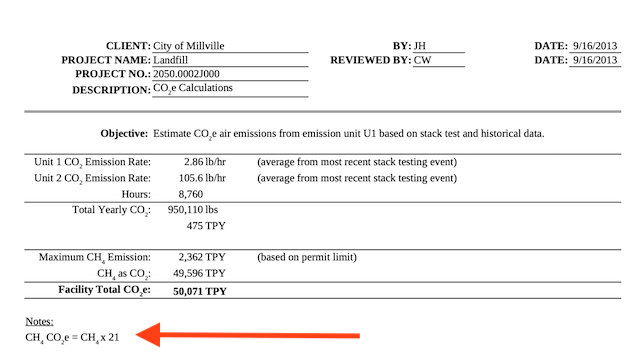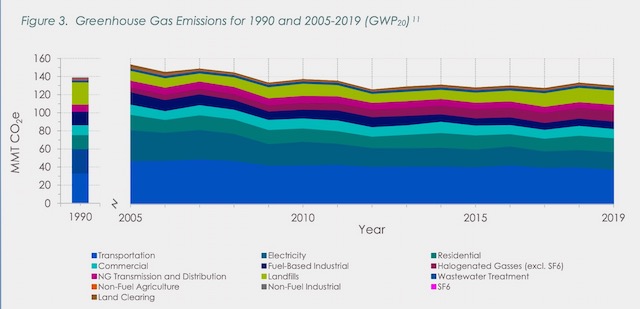Murphy DEP Flouts Law Mandating 20 Year Time Horizon For Calculating Global Warming Potential Of Methane
DEP Downplaying Global Warming Potential Of Methane Emissions
DEP Continues To Fail To Regulate Methane Emissions
On January 13, 2020, NJ Gov. Murphy signed into law legislation that mandates that BPU and DEP use a 20 year time horizon to calculate the global warming potential of methane, based on the Intergovernmental Panel on Climate Change Assessment Report, not the US EPA, not the NJ DEP science, and not based on prior DEP climate Reports and/or emissions inventories.
Buried at the bottom of Gov. Murphy’s Press Release, we find:
S3215 (Greenstein, Singleton/Zwicker, Mukherji, Swain) – Requires State to use 20-year time horizon and most recent Intergovernmental Panel on Climate Change Assessment Report when calculating global warming potential to measure global warming impact of greenhouse gases.
Methane is a potent greenhouse gas, with a warming potential far greater than carbon dioxide. And the warming potential is far greater over a 20 year period than over a 100 year period, which is why this law is so important: (International Energy Agency):
The Intergovernmental Panel on Climate Change (IPCC) has indicated a GWP for methane between 84-87 when considering its impact over a 20-year timeframe (GWP20) and between 28-36 when considering its impact over a 100-year timeframe (GWP100).
The bill’s Prime sponsor said:
Assemblyman Andrew Zwicker (D-Somerset, Mercer, Middlesex, Hunterdon): “The threat of global warming increases every day and while the President has given up our leadership position in curbing greenhouse gases on the world’s stage. This legislation New Jersey will take firm and calculated steps on how we regulate our emissions. Understanding that not all pollutants have the same impact on the Earth’s warming, measuring the ‘global warming potential’ of gases over a 20-year time span will allow us to craft public policies that enable the State to better address how we’ll combat global warming.”
The law went into effect on January 13, 2020 as P.L. 2019, Chapter 319 and was codified as C.26:2C-59
Gov. Murphy and his DEP Commissioner LaTourette constantly claim to be climate leaders, so one would assume that they would aggressively implement this law at DEP and BPU programs that address methane emissions.
One would be very wrong.
Wading through the fine print of DEP’s recent air permits issued to municipal landfills, I noted that DEP issued the permits with estimates of the CO2 emissions presented as total CO2 equivalents in tons per year. But the permits also had a separate table on methane emissions that did not convert methane to CO2 equivalents.
The Millville City landfill draft air permit was open to public comment.
So, I wrote to DEP and asked them to provide their methodology for converting methane emissions to CO2 equivalents.
Today, DEP responded with a spreadsheet that used a conversion factor of 21X (see red arrow above).
That is lower than even the current 100 year timeframe (28 – 36X) , and clearly in violation of the law which mandates a 20 year timeframe and IPCC (84 – 87X).
So, DEP is grossly underestimating the global warming impacts of methane emissions, by at least a factor of 4.
And DEP is blatantly violating the law to do so.
Underestimating warming potential is bad, but much worse is the fact that DEP doesn’t even regulate methane emissions, meaning all those refineries, gas power plants, pipelines, and compressor and transmissions stations don’t control methane emissions or pay pollution emissions fees (and DEP has no legal basis to deny permits).
[Update: To understand the significance of using a 20 year horizon, see DEP’s GHG emissions inventory, where DEP again underestimates the impact of using GWP20 in the text. The reader must go to footnote #7 to learn that using GWP20 significantly increases total emissions and makes methane (and other long lived gases) the second largest source, at 31%) (see DEP, @ page 10)
Using GWP20, the second greatest contributor was highly warming gases,7 which accounted for 16% of net emissions (Figure 5).
7) … Combined, highly warming gases and waste management represent 15% of emissions using GWP100 and 31% using GWP20. ~~~ end update]
[Update: NJ phased out coal power plants and replaced coal with natural gas. But gas can be worse than coal, when methane leaks are considered. A recent published study illustrates the significance of the 20 year horizon: (Evaluating net life-cycle greenhouse gas emissions intensities from gas and coal at varying methane leakage rates:
Numerous studies compare varying temporal and spatial climate impacts of gas utilization compared to coal on an electricity basis [7–9]. These studies find that, if 2%–5% of natural gas produced leaks along supply chains, the electricity generated by natural gas is on par with coal plants in terms of the climate impact over a 20 year timeframe [10–12]. Considering the climate impact over a 100 year time frame, methane leakage rates up to 9% from gas are reported to benefit the coal-to-gas shift in power plants in numerous geographies [7].
… We find that the benefits of gas do not outweigh coal at certain methane leakage rates.
Seems like DEP Commissioner LaTourette is too busy doing press events instead of managing his own agency.
I called out DEP Commissioner LaTourette, with a copy to legislative sponsors of the law and NJ press corps:
Dear Commissioner LaTourette:
Please be advised that the Department’s methane conversion factor for CO2 equivalents used in the Millville City landfill draft air permit violates NJ law. The Department used a 21X conversion factor, which is based on a 100 year timeframe (see below).
NJ law mandates that DEP calculate global warming potential of methane based on a 20 year time horizon:(emphasis mine):
C.26:2C-59 20-year time horizon for calculating global warming potential to measure global warming impact of greenhouse gases.
1. a. Whenever the Department of Environmental Protection, the Board of Public Utilities, or any other State agency calculates a global warming potential for the purposes of assessing the global warming impact of a greenhouse gas, the Department of Environmental Protection, the Board of Public Utilities, or other State agency shall use a 20-year time horizon.
https://pub.njleg.state.nj.us/Bills/2018/PL19/319_.PDF
This law took effect on January 13, 2020.
Please withdraw this Millville draft permit immediately and recalculate and re-public notice the revised draft permit..
Please call up all other landfill and all other air permits issued by DEP after January 13, 2020 that apply to methane emissions and public notice and amend them in accordance with law.
Please revise the Department’s methodology for air permitting and emissions inventory to comply with law for all future air and landfill permits and other methane emission sources.
Bill Wolfe
We’ll keep you posted on DEP’s response, if any. But obviously, they must withdraw the Millville City landfill draft permit.

